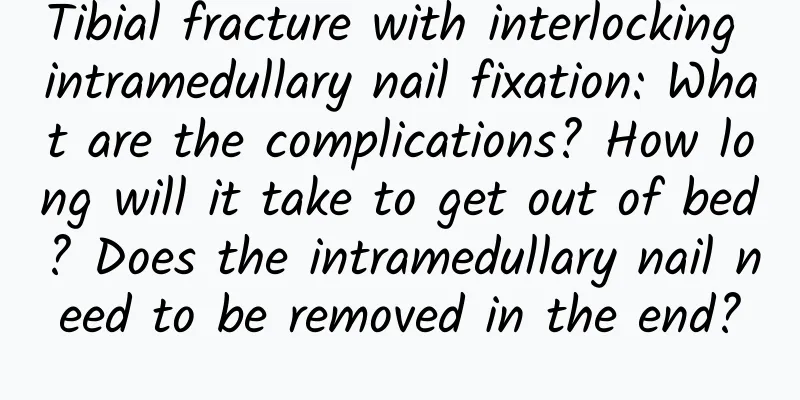Tibial fracture with interlocking intramedullary nail fixation: What are the complications? How long will it take to get out of bed? Does the intramedullary nail need to be removed in the end?

|
Author: Wang Qiwei, attending physician at Peking University First Hospital Reviewer: Li Jun, deputy chief physician, Peking University First Hospital The most commonly used method for surgical treatment of tibial fractures is intramedullary nail fixation, which is mainly applicable to tibial shaft fractures. With the development of medical technology, in addition to tibial shaft fractures, tibial fractures close to the ankle and knee joints, where the articular surface damage is not very serious, can also be fixed with locked intramedullary nails. The locking intramedullary nail fixation technique mainly uses an intramedullary nail to pass through the tibial medullary cavity at the proximal and distal ends of the tibia and fix the intramedullary nail with screws. Because the intramedullary nail fully conforms to the original biomechanics of the bone, functional rehabilitation exercises of the ankle and knee joints can be performed early after surgery. Compared with plate fixation, it has the advantages of less trauma, less bleeding, and faster postoperative recovery. Today we are going to talk about some issues after surgery for tibial fracture fixation with locked intramedullary nailing. As a minimally invasive implantation method, locking intramedullary nail fixation does not directly expose the fracture ends, and its advantage is that it has little impact on the blood supply of the fracture ends. However, the disadvantage of this method is that it is impossible to directly visualize the fracture ends for contact reduction, and it is necessary to rely on intraoperative fluoroscopy and surface observation to confirm whether the fracture is reduced. This may result in the fracture ends not being accurately docked, resulting in greater separation, i.e., poor reduction, which is the main complication of this method. Figure 1 Original copyright image, no permission to reprint Poor fracture reduction will seriously affect healing. The fracture ends cannot grow, which is called delayed healing or non-union, and another surgery is needed. If the fracture is not well positioned, some people may experience limb shortening, and the legs become a little shorter after the operation. There is also abnormal fracture healing, such as shortening deformity, rotation deformity, etc. If poor reduction is found during the operation, and the fracture ends cannot be properly reduced without opening, compromise should not be made, as this will lead to the occurrence of various complications. At this time, an incision should be decisively taken to fully expose the fracture ends, and the intramedullary nail should be inserted after the reduction is completed under direct vision. If poor reduction is found after the operation, the usual practice is to remove the distal locking screw and re-reset the fracture using a closed method under fluoroscopy, and then re-lock the screw to fix it after successful reduction. If this method is still ineffective, the intramedullary nail needs to be removed and the fixation method needs to be redesigned. In addition, possible complications of internal fixation surgery include infection around the incision. For orthopedics, the most serious infection is osteomyelitis. In addition, the intramedullary nail insertion process is not performed under direct vision, but under the cooperation of imaging fluoroscopy. Some important blood vessels and nerves may be damaged during the insertion process. Damage to the nerves will affect the sensory and motor reflexes they control; damage to blood vessels will cause bleeding. Or limb ischemia and necrosis will occur, and amputation will eventually be required. In severe cases, it may even be life-threatening. Of course, this is a very rare complication. Routine postoperative care, such as timely dressing changes on incisions; raising the affected limb to reduce limb swelling; moving adjacent joints, such as the ankle, toes, and knee; doing muscle relaxation exercises, etc. Intramedullary nail fixation surgery for tibial fractures causes little damage, and the postoperative incision pain is relatively mild. After waking up from postoperative anesthesia, the limbs can generally move freely. If the pain is tolerable, patients are encouraged to actively perform functional exercises and get up and move around as soon as possible, but they need to use crutches to get up and move around. Early exercise of joints and muscles will lead to faster recovery. Figure 2 Original copyright image, no permission to reprint There are several stages for walking on the ground. On the first and second days after surgery, as long as the patient is willing and in good physical condition, teach the patient to walk on the ground without weight bearing using crutches. The sole of the foot can be close to the ground, but don't use force. If it doesn't hurt too much, you can walk slowly with weight bearing. There is an adaptation process. Follow-up X-rays are performed one, two, and three months after surgery. X-rays show that the fracture line has become blurred, there are signs of healing, and walking with crutches is basically close to normal weight bearing, and there is no pain or other abnormal sensations at the fracture site. The patient can be encouraged to try to get rid of the crutches and walk with full weight bearing. The fracture will usually heal within 3-4 months after surgery. This is a relative time. Due to different individuals and different degrees of fracture damage, the slowest one may take 6-8 months. Tibial fractures are treated with interlocking intramedullary nailing. Does the intramedullary nail need to be removed after recovery? This is a question that many patients are concerned about. Generally speaking, it does not need to be removed. However, in some special cases, such as young adults and teenagers, the intramedullary nail remains in the body, and part of the force has to be shared by the intramedullary nail. The bones cannot get the force stimulation under normal conditions, which will cause osteoporosis over time. Therefore, for teenagers and young adults, after the fracture is completely stable and healed, the intramedullary nail can be removed or the locking screw can be removed generally 16 months later. For some teenagers, if they do not want to remove it themselves and the sports requirements are not very high, they can also choose not to remove it. There is also a special case, that is, the nail tail protrudes and the locking nail is too long, causing its protruding part to irritate the surrounding soft tissue or skin, causing pain when touched. In this case, it also needs to be removed. There are also some patients who feel psychologically uneasy about having a foreign object in their body. They do not want to have foreign objects remaining in their body, which will cause them anxiety. Psychological counseling has no effect, so these patients also need to have the foreign objects removed. Therefore, except for special populations and special circumstances, it is not necessary to remove the intramedullary nail for most patients after surgery. |
>>: Don’t underestimate the psychological impact of bedwetting on children!
Recommend
What are the symptoms and reactions before giving birth?
As the pregnancy progresses, the mother's emo...
Why do women urinate frequently at night?
Nowadays, some women get up to go to the toilet a...
How big is the fetus at 11 weeks of pregnancy?
For many pregnant mothers, their bellies are not ...
What should I do if there is a lump on the perineum?
If a lump appears on a woman's perineum, she ...
Why is the hair below white?
If you find that the hair below your body turns w...
What are the symptoms after a girl's first time?
Female friends will feel slight pain in the vagin...
How long should menstruation come after breastfeeding?
New mothers don’t understand a lot about postpart...
Apple's iPhone shipments in China surged 12% in March 2024 as it cut prices for promotions
According to foreign media statistics, after Appl...
How do women get ovarian cysts?
Once a woman develops an ovarian cyst, a lump wil...
Pregnant women eat pasta, the baby grows faster
Steamed bun is a food that can be used as a main ...
The difference between painless abortion and curettage
The surgical process of painless abortion and sur...
Pregnancy signs 11 days
In fact, many women do not discover they are preg...
Women must understand these "hints" in their lives
Maybe you have had these little problems, but did...
What is the reason for the sudden decrease in menstrual flow?
In life, many women are prone to some physical pr...
Is salpingography painful? What are the factors that cause pain?
Hysterosalpingography is a common minimally invas...









